Visual Tutorial
Balance Sheet
Balance Sheet
The balance sheet is one of the five main financial statements. It is also known as the statement of financial position.
The balance sheet reports a corporation’s assets, liabilities, and stockholders’ equity as of a moment or point in time.
The balance sheet…
- is one of the main financial statements
- reports a corporation’s assets, liabilities, and stockholders’ equity as of a moment in time
- is also known as the statement of financial position
The outline of a balance sheet is similar to the accounting equation and it must always be in balance. For a corporation the main classifications of the balance sheet are:
Assets = Liabilities + Stockholders’ Equity
For a sole proprietorship the balance sheet’s main classifications are:
Assets = Liabilities + Owner’s Equity
Similar to the accounting equation, a corporation’s balance sheet must always be in balance:
Assets = Liabilities + Stockholders’ Equity
The balance sheet is the only one of the five main financial statements that reports amounts as of a moment or point in time. The income statement, statement of comprehensive income, statement of cash flows, and statement of stockholders’ equity all report amounts for a period of time.
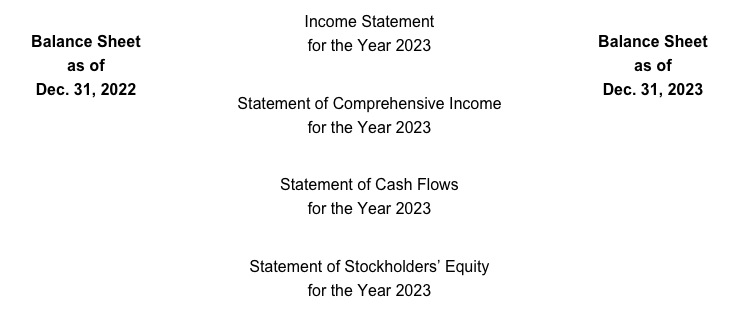
The balance sheet must be prepared according to generally accepted accounting principles (referred to as GAAP or US GAAP). These include very complex, detailed rules and also some basic underlying principles, guidelines, and concepts such as the cost principle, matching principle, full disclosure principle, going concern assumption, conservatism, materiality, objectivity, and others.

The cost principle means that only the business transactions with a cost that accountants can measure are recorded and reported on the balance sheet. For example, a company’s excellent reputation, innovative management, and highly respected brand names that were not purchased will not be reported as assets on the balance sheet. (Yet these might be the company’s most valuable assets.)
The cost principle means some of a company’s most valuable assets will not appear on its balance sheet including the company’s:
- Excellent reputation
- Innovative management and culture
- Highly respected brand names
The cost principle also means that assets such as inventory, land, and buildings will be reported at their cost (or lower) and will not be reported at their higher market values.
(However, some marketable investments will be reported at an amount greater than cost.)
Except for the reporting of certain investments, assets are not reported at more than their cost.
The matching principle requires a company’s financial statements to follow the accrual method of accounting. (Under this method, the receipt or payment of cash does not determine when assets, liabilities, revenues, and expenses will be reported on the financial statements.)
Under the accrual method of accounting:
- Revenues and an asset (accounts receivable) will be reported when the revenues are earned, instead of waiting until the cash is received.
- Expenses will be reported when the expenses occur. If an expense or a loss has not yet been paid, a liability will also be reported.
The matching principle requires the accrual method of accounting, which means:
- A receivable will be reported as an asset when revenues are earned but the company has not yet received the money.
- A liability will be reported when an expense occurred but the company has not yet made the payment.
The accrual method also requires that when a company receives money in advance of earning it, the balance sheet must report a liability for the amount that is not yet earned. (When the unearned amount becomes earned, the liability will be reduced and the income statement will report the amount as revenues).
Under the accrual method of accounting, a company’s balance sheet will report a liability for money received from customers in advance of the company earning it.
The accrual method of accounting also requires that a company’s balance sheet report prepaid expenses as assets until they are used up or have expired. When a prepaid amount expires it becomes an expense on the income statement.
For instance, if a company prepays $6,000 in December for a marketing event that will occur in January, the $6,000 will be reported as an asset on the December balance sheet. In January the $6,000 will be removed from the balance sheet and will be reported as an expense on the January income statement.
Prepaid or unexpired costs are reported on the balance sheet as assets. As those costs expire or are used up they will be reported as expenses on the income statement.
We have merely introduced two of the many accounting principles that will affect the balance sheet. You can learn more about the accounting principles by using all of the materials available from AccountingCoach.com.
We will now move on to a discussion on the balance sheet’s format and contents.
The heading of the balance sheet will include the company’s name, the words “balance sheet” and a date.
The date represents a moment or point in time such as the last instant in an accounting period. We are accustomed to seeing balance sheets with dates such as December 31, March 31, June 30, etc. However, a balance sheet can have any date. Here’s an example of a heading:
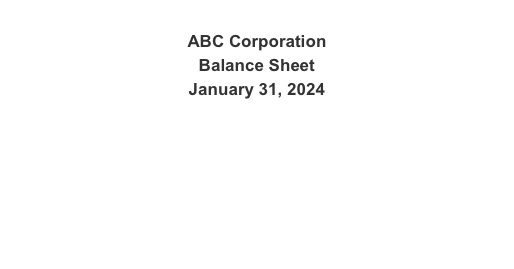
After the heading the balance sheet will report the company’s assets, liabilities, and stockholders’ equity. The amounts are based on past transactions and are to reflect all of the accounting principles and procedures.
In addition to the information on the face of the balance sheet, the notes or footnotes to the financial statements are considered to be part of the balance sheet.
The major parts of the balance sheet are:
- Assets
- Liabilities
- Stockholders’ equity
- Notes to the financial statements
Assets
Assets are a company’s resources or things it owns. Assets are reported only if they have been acquired through a transaction such as a sale, purchase, or donation, and have a future value. Prepaid expenses are reported as assets.
Assets are the things the company owns. Assets are the resources that were acquired in a past transaction which could be measured. Assets have a future value and include prepaid expenses.
Assets are usually presented on the balance sheet according to the following classifications:
- Current assets
- Investments (long-term)
- Property, plant and equipment
- Other assets

Current assets include cash and assets that will turn to cash within one year of the date shown in the heading of the balance sheet. (Some industries allow for a slightly different definition.)
Typically, the current assets are presented in the following order: cash and cash equivalents, temporary investments, accounts receivable, inventory, supplies, and prepaid expenses. (The order is roughly the way items are expected to turn to cash.)
The total amount of current assets is also displayed so that it can be compared to the total amount of current liabilities.
Here is the typical balance sheet presentation of current assets for a company with inventory:
Current assets
Cash and cash equivalents
Temporary investments
Accounts receivable
Inventory
Supplies
Prepaid expenses
Total current assets
Highlights of the Items Reported as Current Assets:
Cash includes currency, coins, checking account balances, and checks received but not yet deposited. (Cannot include checks dated in the future.)
Cash equivalents are highly liquid investments that had a maturity of three months or less when they were purchased. Examples are money market funds, U.S. Treasury bills, and commercial paper.
Temporary investments are short-term investments that are readily marketable securities where the intention is to sell within one year of the balance sheet date. They also include investments that will mature and turn to cash within one year of the balance sheet date.
Highlights of the Items Reported as Current Assets (continued):
Accounts receivable reports the amounts the corporation has a right to receive from its customers as a result of credit sales. Any allowance for uncollectible amounts should be deducted from the amount of accounts receivable.
Inventory or Inventories reports the cost of the goods that a company has purchased or produced but has not yet sold. The cost that is reported is dependent on an assumed cost flow such as FIFO, LIFO, or average. The details of the inventory are included in the notes to the financial statements.
Highlights of the Items Reported as Current Assets (continued):
Supplies are items that will be consumed by the company. For example, when a company has a significant amount of office supplies on hand, their cost is reported here.
Prepaid expenses are costs that have been paid but have not yet expired. As the costs expire, the costs will be reported as expenses on the income statement. A common example is the amount paid for the 6-month or 12-month insurance premiums. Since the insurance premiums are paid in advance, they are reported as prepaid expenses until they expire. Other examples include prepaid legal fees and prepaid marketing costs.
Investments is the first of the long-term asset classifications. It reports long-term investments in certain stocks and bonds, real estate investments, property in the process of being sold, the cash surrender value of life insurance policies owned by the company, assets restricted for a long-term purpose, etc.
Investments is the first of the long-term asset classifications. Investments (if any) will be presented immediately after the current assets.
Property, plant and equipment is the long-term asset classification for reporting the land, buildings, equipment, fixtures, furnishings, automobiles, and other long-term tangible assets used in the business. Many accountants refer to these assets as the company’s fixed assets or as the company’s plant assets.
These assets are reported at amounts no greater than their cost even if their current market values are greater.
Property, plant and equipment is the balance sheet section appearing after long-term investments. In this section the long-term assets used in the business are listed at their cost. Examples of the items are land, buildings, equipment, fixtures, furnishings, vehicles, etc.
Except for land, the cost of a plant asset must be depreciated to expense over the asset’s useful life. The amount that has been depreciated is reported as accumulated depreciation and it is deducted from the costs reported under property, plant and equipment.
Also presented in the property, plant and equipment section is a deduction for the accumulated depreciation that pertains to these assets.
Other assets is usually the final long-term asset classification and could include long-term deferred charges and goodwill.
Other assets is the final long-term asset category. Examples include long-term deferred charges that do not fit into the previous classifications.
Here is a listing of the assets often reported on a balance sheet:
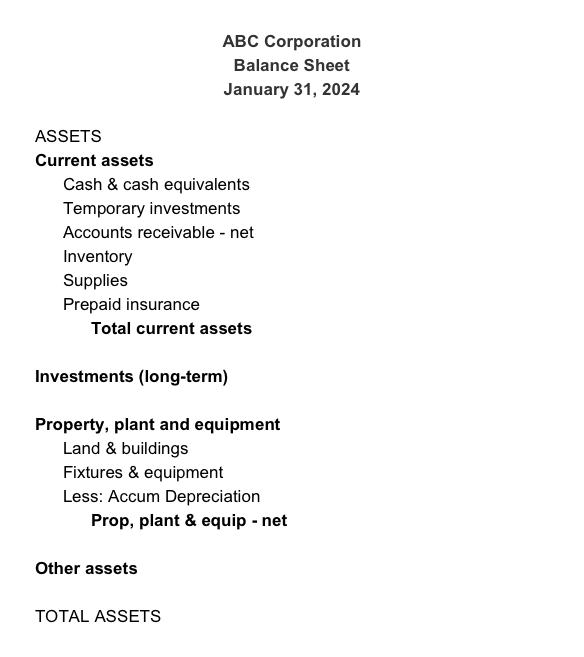
Liabilities
Liabilities can be viewed as claims against the company’s assets and also as one of the sources of the company’s assets.
Liabilities are presented on the balance sheet as follows:
- Current liabilities
- Long-term liabilities including deferred income taxes.
Liabilities are the company’s obligations — amounts the company owes. Liabilities include customer deposits and deferred or unearned revenues.
The balance sheet classifications for liabilities include:
- Current liabilities
- Long-term or noncurrent liabilities
Current liabilities are the obligations that are payable within one year of the date shown in the heading of the balance sheet. (Some industries allow for a slightly different definition.) An obligation is shown as a current or short-term liability only if it will require the use of a current asset or will create another current liability. Current liabilities include amounts received from customers in advance of being earned.
Current liabilities are often listed in the following order:
- The amounts of loan principal payments that are due within one year of the balance sheet date
- The amount of the accounts payable
- The remaining current liabilities
The total amount of current liabilities is also displayed so that it can be compared to the total amount of current assets.
Here is an example of the balance sheet presentation of current liabilities:
Current liabilities
Short-term notes payable
Current portion of long-term debt
Accounts payable
Income taxes payable
Accrued expenses
Deferred revenues
Total current liabilities
Highlights of the Items Reported as Current Liabilities:
Short-term notes payable are the amounts borrowed by a company that must be repaid in less than one year.
Current portion of long-term debt is the principal amount that is coming due within one year of the balance sheet date. Mortgage loans and vehicle loans are examples of long-term loans that require principal payments to be made during the one-year period following the date of the balance sheet.
Accounts payable represents the amounts owed to suppliers/vendors who have provided the company with goods and services on credit. For example, a company has received the goods and the supplier’s related invoice, but the company has 30 days before it must remit payment.
Highlights of the Items Reported as Current Liabilities (continued):
Income taxes payable is the amount of income taxes that must be remitted within one year of the balance sheet date.
Accrued expenses are the amounts owed for goods and services but the suppliers/vendors have not yet billed the company. This will also include the amounts owed for employee related wages and benefits that have occurred but have not yet been processed (if these are not listed separately).
Unearned revenues or deferred revenues are the amounts received from customers in advance of being earned. As the amounts become earned, this liability is reduced and the income statement will report the earned amounts as revenues.
Long-term liabilities (or noncurrent liabilities) are the obligations that will not be due within one year of the balance sheet date. These include the long-term portion of a mortgage loan, bonds payable, deferred income taxes, liability for postretirement or postemployment benefits, and other long-term liabilities.
Included near the end of the long-term liabilities there is often a line that reads “Commitments and contingencies (see Notes)”. No amount is reported as its purpose is to inform readers that the notes to the financial statements may contain information about potential liabilities.
Long-term liabilities include:
- Bonds payable
- Mortgage loans payable
- Postretirement benefits liability
- Deferred income taxes
- A reference regarding commitments and contingencies
Highlights of the Items Reported as Long-term or Noncurrent Liabilities
Bonds payable are debt securities issued by a corporation. Bonds are formal promises to pay interest (usually every six months) and the principal amount at the maturity date.
Mortgage loans payable is long-term debt that has real estate as collateral. Mortgage loans often require monthly payments of interest and principal. The amount of principal that must be paid within one year of the balance sheet date is reported as a current liability. The principal amount that is not due within one year of the balance sheet date is reported here.
Highlights of the Items Reported as Long-term or Noncurrent Liabilities (continued):
Postretirement benefits liability includes the obligations a company has agreed to pay to its retirees. For example, if the company agreed to pay the retirees’ health insurance cost for the remainder of their lives, the estimated cost of that benefit is reported here.
Deferred income taxes represent the income taxes that are not yet due even though they were reported as income tax expense on the corporation’s income statement. Often they are associated with the difference in the timing of the depreciation expense on the tax return versus the financial statements.
Commitments and contingencies is often a line on the balance sheet that does not have an amount listed. Its purpose is to refer the readers to certain disclosures in the notes to the financial statements.
Stockholders’ Equity
Stockholders’ equity (or owner’s equity) is the difference between a corporation’s total assets and its total liabilities. Stockholders’ equity includes amounts received from issuing shares of stock and also from the corporation’s net income from the time the corporation began minus the dividends to stockholders from the time the corporation began.
The notes to the financial statements also provides additional information about the balance sheet and the other financial statements.
Stockholders’ equity is the difference between a corporation’s total assets and the total liabilities. (For a sole proprietorship it is named owner’s equity.) Stockholders’ equity includes the amounts that were received when shares of stock were issued plus the amount of earnings minus dividends since the business began.
Stockholders’ equity (also known as shareholders’ equity) consists of these components:
- Paid-in capital or contributed capital
- Treasury stock
- Retained earnings
- Accumulated other comprehensive income
Paid-in capital is the amount received by the corporation when it originally issued shares of its stock. If preferred stock has been issued, the preferred amount is shown separately from the common stock. If the stock has a par value, that amount is also shown separately.
Treasury stock is actually a reduction of stockholders’ equity. The amount reported is usually the cost of repurchasing its shares of stock that have not been retired.
Retained earnings is the cumulative amount of the corporation’s earnings minus the dividends it has declared since the corporation was formed.
Accumulated other comprehensive income reports the amounts for items that are not included in the corporation’s earnings or retained earnings. Examples include foreign currency translation adjustments and unrealized gains/losses from hedging and postretirement benefit plans.
Stockholders’ equity can be summarized as follows:
- Paid-in capital: the amounts received by the corporation when it issued new shares of stock
- Treasury stock: a subtraction for the cost of the corporation’s stock that it repurchased but has not retired
- Retained earnings: the corporation’s earnings that have been earned minus the dividends declared since the corporation began
- Accumulated other comprehensive income: certain gains and losses that were not included in the corporation’s earnings and retained earnings
Since the retained earnings portion of stockholders’ equity is increased by the corporation’s earnings, much of the change occurring during the accounting period can be found on the income statement.

The change in retained earnings during the most recent accounting period is partially explained by the corporation’s income statement which reports its revenues, expenses, gains, and losses.
Below is a more complete balance sheet:
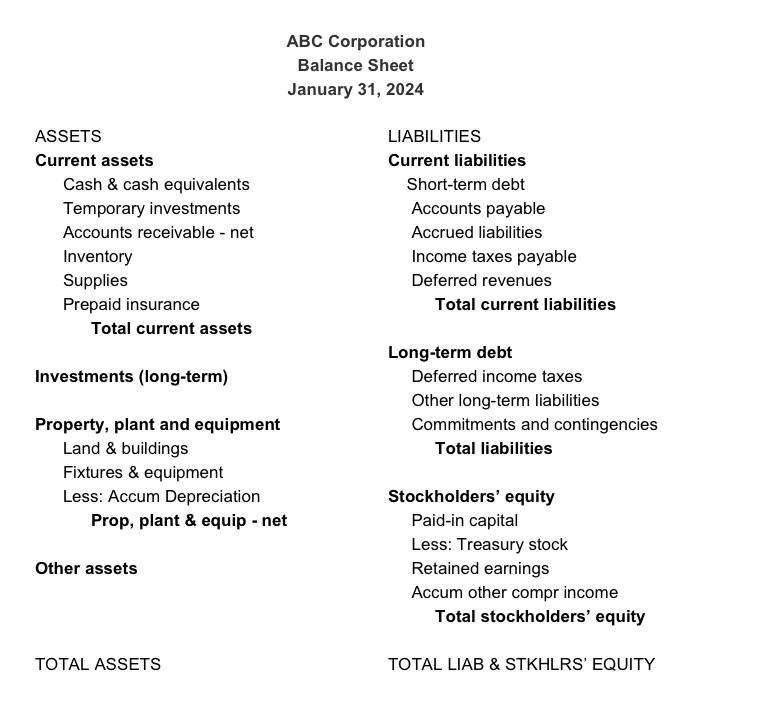
In order for the balance sheet to be more useful, accountants should prepare comparative balance sheets. Comparative balance sheets report the amounts for two dates as shown in the partial sample balance sheet below:
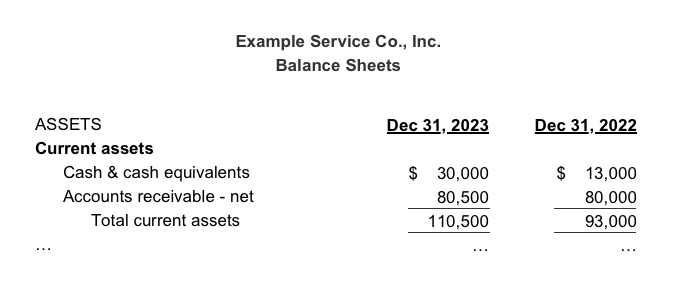
The balance sheet is used by lenders, investors, and suppliers to assess the corporation’s ability to meet its present and future obligations.
For example, the amount of the current assets is compared to the amount of current liabilities to determine 1) the amount of working capital (current assets minus current liabilities), and 2) the current ratio (current assets divided by current liabilities).
The balance sheet also indicates the corporation’s financial leverage, which is the total liabilities in relationship to the stockholders’ equity or total assets.
The balance sheet reveals a corporation’s:
- Working capital: current assets minus current liabilities
- Current ratio: current assets divided by current liabilities
- Financial leverage: total liabilities compared to stockholders’ equity and total liabilities compared to total assets
Book Value
An asset’s book value is the asset’s cost minus the asset’s accumulated depreciation up to the date of the balance sheet. Depreciation was recorded in order to match the cost of the asset to the revenues earned by using the asset. The asset’s book value does not indicate the current market value of the asset.
The book value of a corporation is the amount of its reported stockholders’ equity. In other words, it is the difference between the amounts reported as assets minus the amounts reported as liabilities. Since some of the corporation’s most valuable assets (reputation, brand names, creative culture) are not reported as assets on the balance sheet, the amount of stockholders’ equity does not indicate the current market value of the corporation.
The End
There are more resources to assist you under our topic Balance Sheet.
Turn on study mode to focus
Balance Sheet Outline
- Read our Explanation (8 Parts) Free
- Take our Practice Quiz Free
- Review our Visual Tutorial
- Watch our Financial Statements Video Training
- Review our Flashcards
- Solve our Word Scramble Free
- Solve our Crossword Puzzle #1 Free
- Solve our Crossword Puzzle #2 Free
- Review our Sample Business Forms
- Review our Cheat Sheet
- Take our Quick Test #1
- Take our Quick Test #2 with Coaching
- Earn our Balance Sheet Certificate of Achievement
Learn How to Advance Your Accounting and Bookkeeping Career
- Perform better at your current job
- Refresh your skills to re-enter the workforce
- Pass your accounting class
- Understand your small business finances
Featured Review
"AccountingCoach saved my job. I have had bookkeeping jobs on and off for the past ten years but never any formal training. I recently accepted a position and it was evident to me after the first day that I was way out of my league. Because of how AccountingCoach is structured, I was able to study at a fast pace and get the info I needed to be more productive at work. Thank you for presenting the information in such a basic, uncomplicated way." - Tammy Y.




